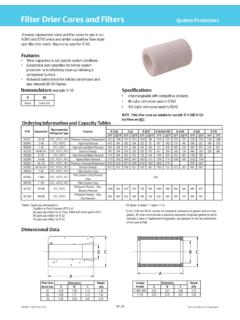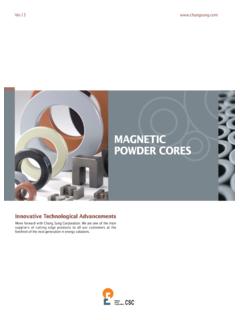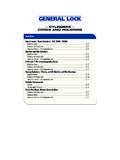Transcription of The International Magnetics Association
1 The International Magnetics Association An operating group of: The Transformer Association 1300 Sumner Avenue Cleveland, OH 44115 Telephone: (216) 241-7333 Facsimile: (216) 241-0105 THIS USER S GUIDE This User s Guide is intended to acquaint the new user with the advantages, limitations, and applications of soft ferrites; and also to enhance the knowledge of more experienced users. CORE STANDARDS IMA Standards now available: IMA-STD 110, Standard Specification for Pot Style Cores IMA-STD 120, Standard Specification for Ferrite Threaded Cores IMA-STD 130, Standard Specification for Ferrite U, E, & I Cores IMA-STD 140, Standard Specification for Ferrite Toroid Cores IMA WORKING GROUP MEMBERS Adams magnetic Products Company 888 Larch Ave. Elmhurst , IL 60126 (P) 800-275-6312 (F) 732-451-0339 Allstar Magnetics 6205 NE 63rd Street Vancouver, WA 98661 (P) 360-693-0213 (F) 360-693-0639 Dexter Magnetics 1050 Morse Ave. Elk Grove Village, IL 60007 (P) 847-956-1140 (F) 847-956-8205 Elna Magnetics 203 Malden Turnpike Saugerties, NY 12477 (P) 800-553-2870 (F) 845-247-0196 EPCOS 186 South Wood Ave.
2 Iselin, NJ 08830 (P) 732-603-4300 (F) 732-906-4395 Fair-Rite Products 1 Commercial Row Wallkill, NY 12589 (P) 845-895-2058 (F) 845-895-2629 Ferroxcube 1200 Golden Key Circle Suite 233 El Paso, TX 79925 (P) 915-599-2616 (F) 915-599-2555 Magnetics 110 Delta Drive Pittsburgh, PA 15238 (P) 412-696-1333 (F) 412-696-1300 Micro Metals 5615 East LaPalma Ave. Anaheim, CA 92807 (P) 714-920-9400 (F) 714-970-0400 MTL Distribution 23167 Temescal Canyon Road Corona, CA 92883 (P) 951-270-0215 (F) 951-270-0245 National Magnetics Group 1210 Win Drive Bethlehem, PA 18017 (P) 610-867-7600 (F) 610-867-0200 TSC Ferrite International 39105 North Magnetics Blvd. Wadsworth, IL 60083 (P) 847-249-4900 (F) 847-249-4988 VAC Sales USA 2935 Dolphin Drive Suite 102 Elizabethtown, KY 42701 (P) 270-769-1333 (F) 270-765-3118 SECTION , INTRODUCTION TO SOFT FERRITES In the early days of the electrical industry, the need for magnetic materials was served by iron and its magnetic alloys. However, with the advent of higher frequencies, the standard techniques of reducing eddy current losses, using lamination or iron powder cores, were no longer efficient or cost effective.
3 This realization stimulated a renewed interest in magnetic insulators as first reported by S. Hilpert in Germany in 1909. It was readily understood that if the high electrical resistivity of oxides could be combined with desired magnetic characteristics, a magnetic material would result that was particularly well suited for high frequency operation. Research to develop such a material was being done in various laboratories all over the world, such as by V. Kato, T. Takei, and N. Kawai in the 1930 s in Japan and by J. Snoek of the Philips Research Laboratories in the period 1935-45 in the Netherlands. By 1945 Snoek had laid down the-basic fundamentals of the physics and technology of practical ferrite materials. In 1948, the Neel Theory of ferrimagnetism provided the theoretical understanding of this type of magnetic material. Ferrites are ceramic, homogeneous materials composed of various oxides with iron oxide as their main constituent. Ferrites can have several distinct crystal structures.
4 However, for this brochure, we are only concerned with the magnetically soft ferrites, which have a cubic crystal structure. Based upon the chemical composition, soft ferrites can be divided into two major categories, manganese-zinc ferrite and nickel-zinc ferrite. In each of these categories many different MnZn and NiZn material grades can be manufactured by changing the chemical composition or manufacturing technology. The two families of MnZn and NiZn ferrite materials complement each other and allow the use of soft ferrites from audio frequencies to several hundred megahertz. The first practical soft ferrite application was in inductors used in LC filters in frequency division multiplex equipment. The combination of high resistivity and good magnetic properties made these ferrites an excellent core material for these filters operating over the 50-450 kHz frequency range. The large scale introduction of TV in the 1950 s was a major opportunity for the fledgling ferrite industry.
5 In TV sets, ferrite cores were the material of choice for the high voltage transformer and the picture tube deflection system. For four decades ferrite components have been used in an ever widening range of applications and in steadily increasing quantities. Table 1A is a partial listing of major applications for soft ferrites. Table 1B is a partial listing of soft ferrite design advantages. Table 1A Soft Ferrite Applications magnetic DEVICES: USED IN: Power transformer and chokes HF power supplies and lighting ballasts Inductors and tuned transformers Frequency selective circuits Pulse and wideband transformers Matching devices magnetic deflection structures TV sets and monitors Recording heads Storage devices Rotating transformers VCRs Shield beads and chokes Interference suppression Transducers Vending machines and ultrasonic cleaners Table 1B Design Advantages High resistivity Large material selection Wide range of operating frequencies Versatility of core shapes Low loss combined with high permeability Low cost Time and temperature stability Lightweight SECTION , PROCESSING Ferrites are manufactured by processing a composition of iron oxide mixed with other major constituents such as oxides or carbonates of either manganese and zinc or nickel and zinc.
6 The basic process is common to most ceramic process technologies and can be divided into four major functions: Preparation of the powder Forming powder into cores Firing and sintering Finishing the ferrite components Figure 1 Processing Flow Diagram Please note that quality assurance steps are not shown in order to simplify the diagram. Quality Assurance however, does play an integral part in the manufacturing process and will be discussed in the next section. Powder Preparation The first step in the production of powder starts with the chemical analysis of the raw materials, the oxides or carbonates of the major constituents. The purity of these materials contributes directly to the quality of the final product and needs to be controlled to assure a batch-to-batch consistency. The exact amount of the major constituents is weighed and thoroughly mixed into a homogeneous mixture. This mixing can be done in a dry process, or water can be added to form a slurry and then mixed in a ball mill.
7 When wet mixing is used, a drying procedure is required to reduce the moisture content prior to calcining. Calcining is a preferring process in which the powder temperature is raised to approximately 1000 C in an air atmosphere. During the calcining there is a partial decomposition of the carbonates and oxides, evaporation of volatile impurities and a homogenation of the powder mixture. There is a degree of spine1 conversion during calcinin g and this pre-firing step also reduces the shrinkage in the final sintering. After calcining the powder is mixed with water and the slurry is milled to obtain small and uniform particle sizes. At this stage of the process binders and lubricants are added. The type of binder and lubricant is determined by the forming technology. The last step in the powder preparation is to spray dry the slurry in a spray dryer. Figure 2 illustrates the powder preparation flow. Figure 2 Powder Preparation Flow Chart Forming The second step in the ferrite processing technology is the forming of the component.
8 The most often used technique is dry pressing the powder into the core configuration. Other techniques are extruding and isostatic pressing. Figure 3 Dry Pressing Techniques Dry pressing or compacting is done using a combined action of top and bottom punches in a cavity such that a part of uniform density is formed. Today s presses and tooling technology enable the pressing of multiple parts and very complex core shapes. Since compacting is only along the vertical axis, the only size adjustment that can be made is of the press height. See Figure 3 for some aspects of this pressing technique. Isostatic pressing typically uses flexible containers, such as thick rubber molds, which have very rudimentary shapes (blocks, rods, discs, ). The container is filled with non bindered powder, sealed, and placed inside a pressure chamber or vessel (Isostatic press). Pressure is increased to a specific level, commonly 10K psi to 30K psi, and then decreased. The container is then removed from the vessel, unsealed and the pressed form is withdrawn ready for sintering.
9 Organic binder is not used in this process because of the mismatch between the rate at which the binder is burned out during sintering and the shrinkage that is occurring at the same time. This mismatch could cause the product being sintered to literally tear itself apart. Isostatic pressing produces material with high, uniform density suitable for machining into complex geometries. This is valuable for prototype designing in which no dry press molds (tools) exist. This process can also produce geometries that cannot be produced using standard pressing techniques such as large core volume or non-pressable shapes. Extruding is typically used to form long, small cross section parts such as rods and tubes. The spray dried powder is mixed with a moisturizing plasticizer that allows the powder to be forced through the appropriate extruding die. In all of the above forming methods the dimensions of the forming tool must be larger than the final product dimensions by a factor that allows for shrinkage during sintering.
10 Sintering This is the most critical step in the manufacturing of ferrites. It is during this phase of the process that the product achieves its final magnetic and mechanical characteristics. Sintering of maganese-zinc ferrites requires an equilibrium between time, temperature and atmosphere along each phase of the sintering cycle. Sintering starts with a gradual ramping up from room temperature to approximately 800 C as impurities, residual moisture, binders, and lubricants are burned out of the product. The atmosphere in this part of the sintering cycle is air. Figure 4 TypicalMnZnSinteringCycle The temperature is further increased to the final sinter temperature. of IOOO- 1500 C, depending upon the type material. While the temperature is increasing, a non oxidizing gas is introduced into the kiln to reduce the oxygen content of the kiln atmosphere. During the cool-down cycle a reduction of oxygen pressure is very critical in obtaining high quality MnZn ferrites. The sintering of nickel-zinc ferrites occurs at lower temperatures, in the range of 1000-1200 C.






